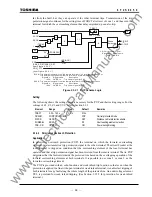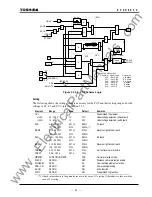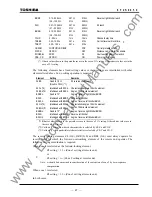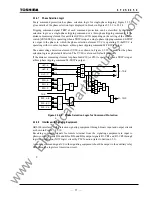
62
6
F
2
S
0
8
5
0
The following elements have fixed setting values or their settings are interlinked with other
elements listed above. So no setting operation is required.
Element Setting
Remarks
Z4BS
Fixed to 1.5
Ω
Z4 reverse offset reach
(Fixed to 7.5
Ω
) (*1)
Z4S
θ
(*2)
Interlinked with Z3S
θ
Characteristic angle of Z4 mho element
Z4BS
θ
(*3)
Interlinked with ZBS
θ
Angle of Z4 directional element
BRRS
θ
Fixed to 75°
Angle of reverse right blinder BRRS
BRLS
Interlinked with BRRS Reverse left blinder
BRLS
θ
Interlinked with BFLS
θ
Angle of reverse left blinder BRLS
Z4G
θ
(*2)
Interlinked with Z3G
θ
Characteristic angle of Z4 mho element
Z4BG
θ
(*3)
Interlinked with ZBG
θ
Angle of Z4 directional element
BRRG
θ
Fixed to 75°
Angle of reverse right blinder BRRG
BRLG
Interlinked with BRRG Reverse left blinder
BRLG
θ
Interlinked with BFLG
θ
Angle of reverse left blinder BRLG
(*1) Ohmic values shown in the parentheses are in the case of 1 A rating. Other ohmic values are in the
case of 5 A rating.
(*2) Valid only when mho-based characteristic is selected by ZS-C and ZG-C.
(*3) Valid only when quadrilateral characteristic is selected by ZS-C and ZG-C.
The reverse looking Z4 (G,S), BRR (G,S) and BRL (G,S) must always operate for reverse faults
for which the forward overreaching element of the remote end operates. The following setting
coordination is required.
When zone 2 is selected as the forward looking element:
Z4 setting = 1.2
×
(Zone 2 setting at remote end)
When zone 3 is selected:
Z4 setting = 1.2
×
(Zone 3 setting at remote end)
In both cases:
BRR setting = 1.2
×
(BFR setting at remote end)
2.3.2.3 Unblocking Overreach Protection
Application
If a power line carrier is used as the telecommunication media, there is a possibility that the
dependability of the PUP and POP could be reduced. This is because the trip permission signal
must be transmitted through the fault point and the attenuation of the signal may cause the PUP
and POP to fail to operate. To solve this problem, unblocking overreach protection (UOP) is
applied.
The signal transmitted under the UOP is a trip block signal and this is transmitted continuously
during non-fault conditions. When the forward overreaching element operates, transmission is
stopped. At the remote end, the non-receipt of a trip block signal is recognized as an actual trip
permission signal and tripping is executed on condition that the local forward overreaching
element operates.
In this system, the transmitted signal is a trip block signal, and transmission of that signal is
required only in the case of external faults. Therefore, even if power line carrier is used, a failure to
operate or false operation due to attenuation of the signal would not be experienced.
If the modulation method of the telecommunication circuits is a frequency shift method,
frequencies f1 and f2 are assigned to the trip block signal and trip permission signal, respectively.
The receive end recognizes signals CR1 and CR2 as corresponding to respective frequencies as
www
. ElectricalPartManuals
. com
Summary of Contents for GRL100-701B
Page 329: ... 328 6 F 2 S 0 8 5 0 w w w E l e c t r i c a l P a r t M a n u a l s c o m ...
Page 339: ... 338 6 F 2 S 0 8 5 0 w w w E l e c t r i c a l P a r t M a n u a l s c o m ...
Page 351: ... 350 6 F 2 S 0 8 5 0 w w w E l e c t r i c a l P a r t M a n u a l s c o m ...
Page 381: ... 380 6 F 2 S 0 8 5 0 w w w E l e c t r i c a l P a r t M a n u a l s c o m ...
Page 413: ... 412 6 F 2 S 0 8 5 0 w w w E l e c t r i c a l P a r t M a n u a l s c o m ...
Page 417: ... 416 6 F 2 S 0 8 5 0 w w w E l e c t r i c a l P a r t M a n u a l s c o m ...
Page 453: ... 452 6 F 2 S 0 8 5 0 w w w E l e c t r i c a l P a r t M a n u a l s c o m ...
Page 457: ... 456 6 F 2 S 0 8 5 0 w w w E l e c t r i c a l P a r t M a n u a l s c o m ...
Page 473: ...w w w E l e c t r i c a l P a r t M a n u a l s c o m ...
















































